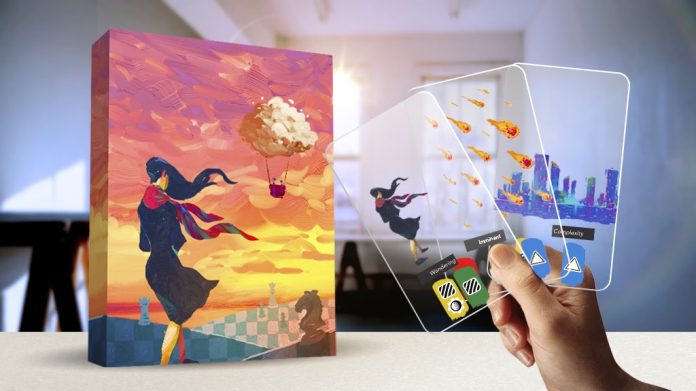Welcome, folks, to the visual feast of CANVAS by Road to Infamy Games, also known as R2i Games. It was designed by Jeff Chin and Andrew Nerger but first and foremost I have to get the required comment out of the way. The first thing I tell anybody about this game is “This game is SO PRETTY. It’s gorgeous. It’s really visually appealing, I’m serious. I cannot say it enough.” So now that I have said that, I will try to avoid repeating myself because I don’t want to give the editor a reason to chop up my game review.
The first thing you can’t fail to notice about this art-focused game is the beautiful art of Luan Huynh and the fact that the box is created like a painting, so much so that there is a spot in the back where you can actually mount it onto your game room wall. I would love to do this one day because pulling it off the wall to play a game amuses me and I love looking at the cover art almost as much as I enjoy perusing the transparent art cards.
The game includes a playmat where you lay out your Criteria Scoring cards and the transparent art card marketplace. The area above the mat has the Scoring ribbon awards for each time you meet a goal on those Criteria cards. Each criteria card will tell you what combinations of Hue, Tone, Texture, and Shape icons you need, in which order, for different types of ribbon. Each transparent card has these icons in different locations on the bottom which will help you decide whether they can help you pick up ribbons during scoring, which I will cover later. Each Criteria can be met multiple times for multiple ribbons, but each icon can only be used once on the card for that specific criteria to be met.
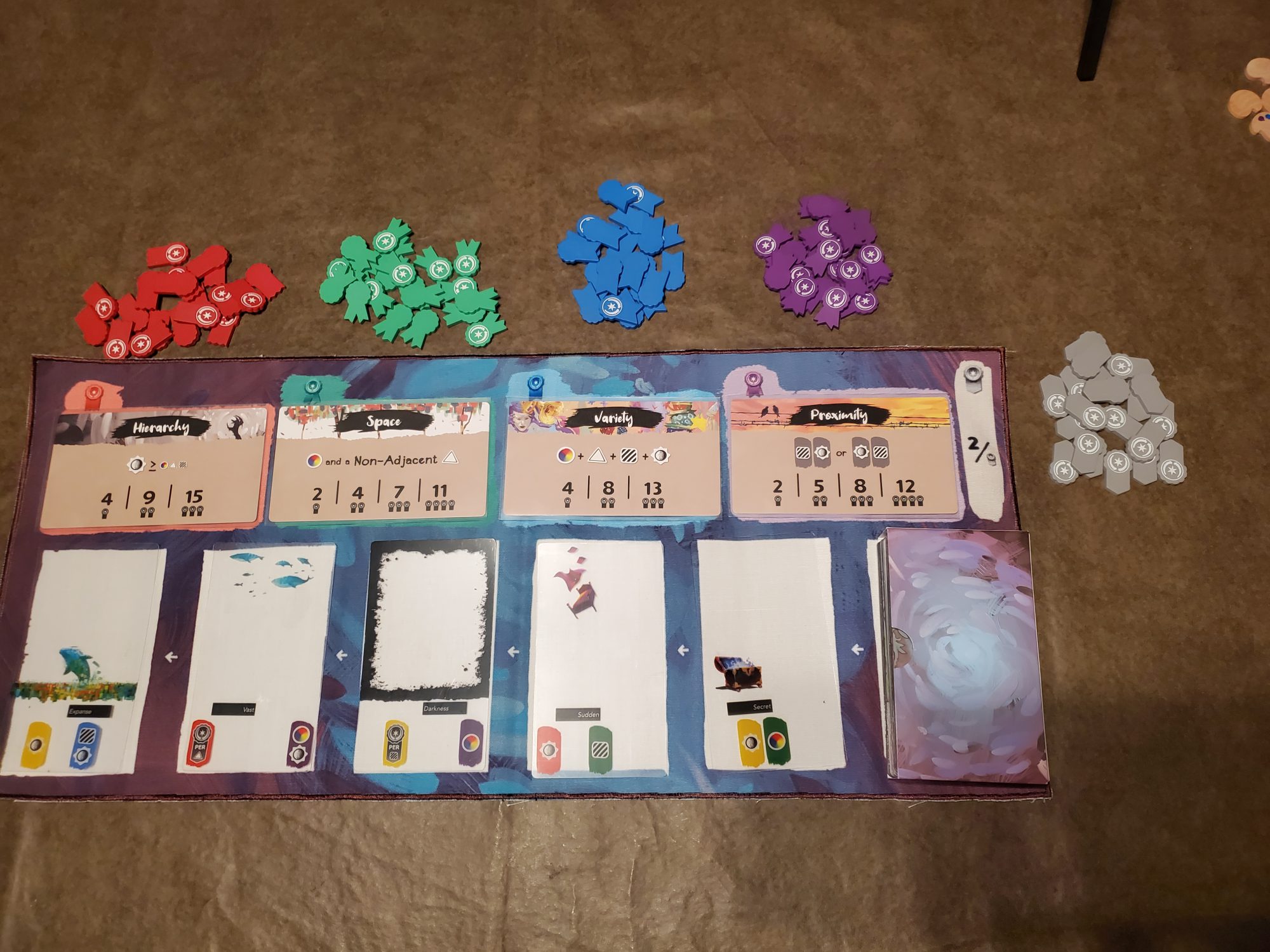
The cards are kept in a deck box and drawn out individually as the active player chooses one of five cards in the market area. No peeking down the line! The card furthest from the box is a free pick; each subsequent card in the market will cost you Inspiration tokens. One token is laid on each card you skip until you pick your piece. As each card is chosen, the rest slide down the market toward the first spot and the freshest cards are always placed in the spot next to the box.
When a player chooses an art card that has been skipped over by someone else, they also collect those Inspiration tokens. Each player only gets a handful of these tokens, but I’ve found they circulate oftenwhen you are all plotting entirely different paintings. It is rare to hit every criteria on the board with one painting, so some folks just pick a couple of possible scoring cards and try to hit those goals repeatedly. Sometimes everybody is focused on the same scoring criteria, meaning that your icon availability on the bottom of the cards can get a little scarce. There have been a couple of instances when a certain element (Tone, for example) didn’t show up in the market for a couple rounds and when one finally did, it was yanked away by the active player sitting on a hoard of Inspiration. (At least, that was the comment tossed out the other night, which I will not dignify with a response!)
Each card is meant to be layered into a work of art that is a sleeve of 3 drafted cards and a colorful background piece that you present for scoring ribbons. The scoring changes every game, as criteria cards are dealt to the play surface at the beginning of each game. Remember that these icons are listed at the bottom of each transparent card, so the order you layer them can not only change the view of your art piece or the title you will present, but the possible scoring combos at the bottom. The order in which you layer those cards can make a big difference!
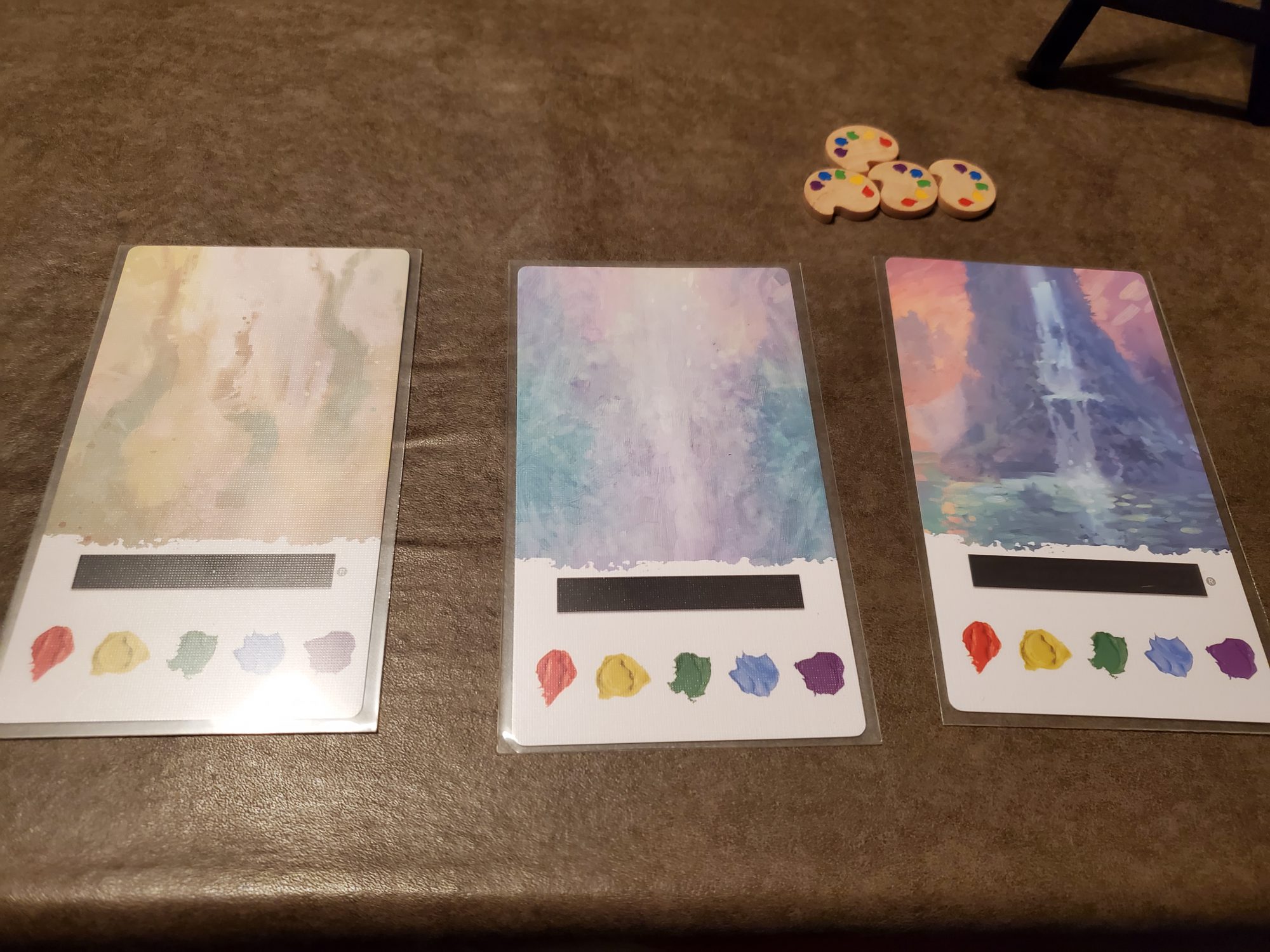
You may need to sacrifice the perfect name or change the perspective of your piece in order to get the most points upon presentation. That said, if you aren’t a terribly competitive person, you may be happy just creating the perfect artwork with the most intriguing name and be content with brushing off the judgment of awards. This often happens when you play the game with young volunteers, which can be just as entertaining as watching players try to scalp points by swiping the card everyone was eyeing on the table.
Your hand size is limited, so choose carefully! Once you reach 5 cards, you must assemble a piece to present. It is not easy to score from every criteria card each time you present. Given that each player only presents 3 art pieces for score before the game ends, you only have so many chances to max out your points.
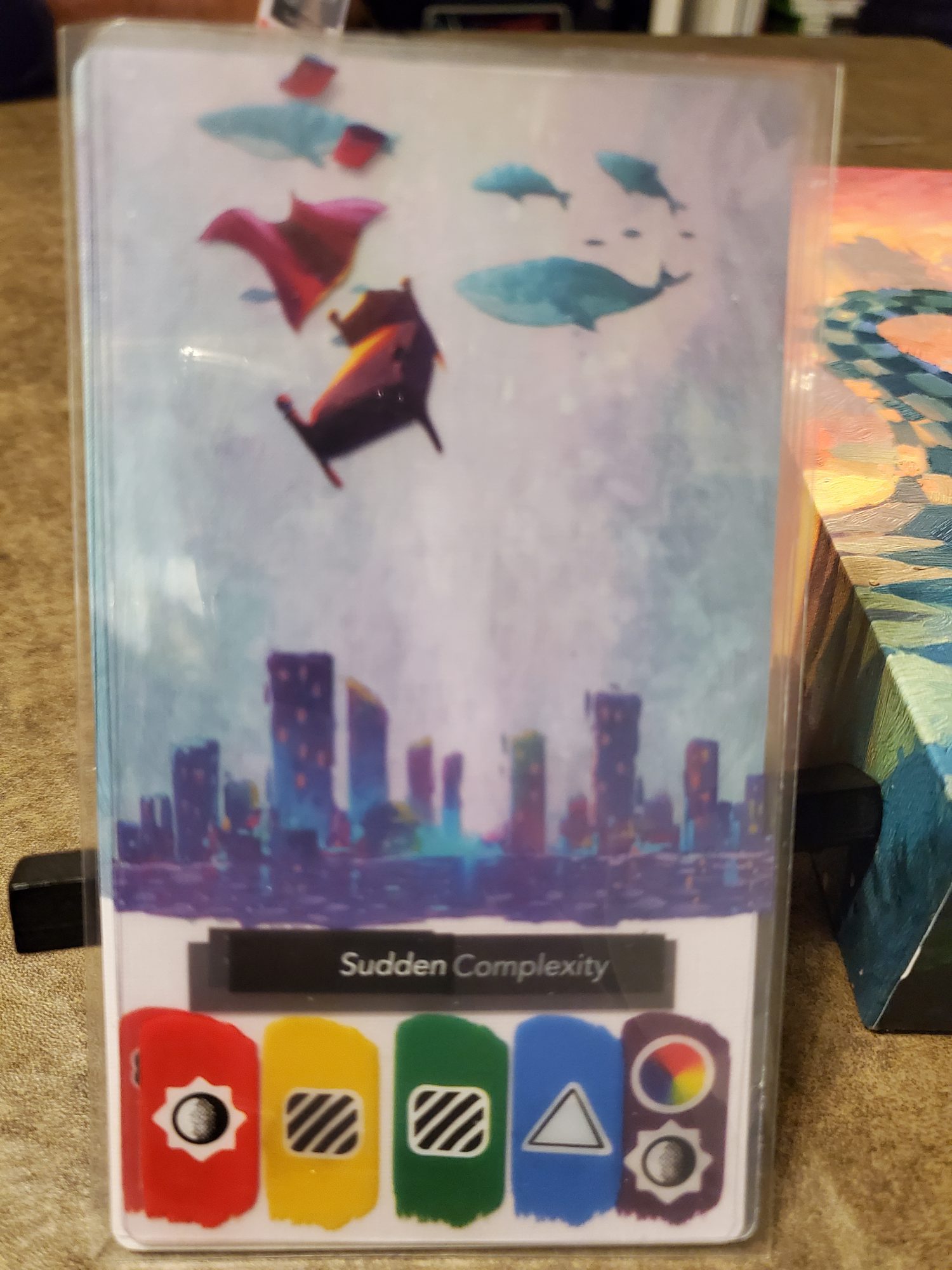
One thing I have not tried yet is just picking one or two criteria cards and just trying to get those awards every time, multiple times per painting. Each of those cards changes the point value of the ribbons based on how many you have. I would like to see if picking one goal over and over gives me significant value over just trying to hit one goal, any goal, once I have grabbed my favorite art piece. I sometimes get distracted with the look of the art with something already in my hand at the expense of the points. There’s nothing wrong with that, by the way, unless you are trying to compete for points.
I have noticed that my third painting usually ends up being the least cool looking. I usually enjoy playing with the layered cards for the first round or two and then I start getting nervous at my fellow players’ piles of ribbons and try to cram a lot of points into my last showpiece. I should probably care less about the points, but when I play with the two competitive types in my home I want to look like I was at least paying attention to the scoring. More than once I have just sat down and made cool projects, though, and thought about making a house rule of an extra gray (2 point) ribbon if everyone at the table is impressed by a particular piece. I haven’t implemented this yet, but I still may.
More credit should be given for a particularly fascinating show piece that everyone enjoys staring at. When I consider the lack of “Best in Show” award or “Most Creative Name” or “Ingeniously Perfect Piece”, I think that some more scoring should be available. Especially since the last time we played this, two players tied in points and tied again with the “tiebreaker” (number of Inspiration Tokens on hand) and finally we sent photos to someone familiar with the game and had them vote on a winner. That winner was me, and thankfully the person who voted didn’t know which submission belonged to which person. So in my head, I got the invisible “Best in Show” award of the night.
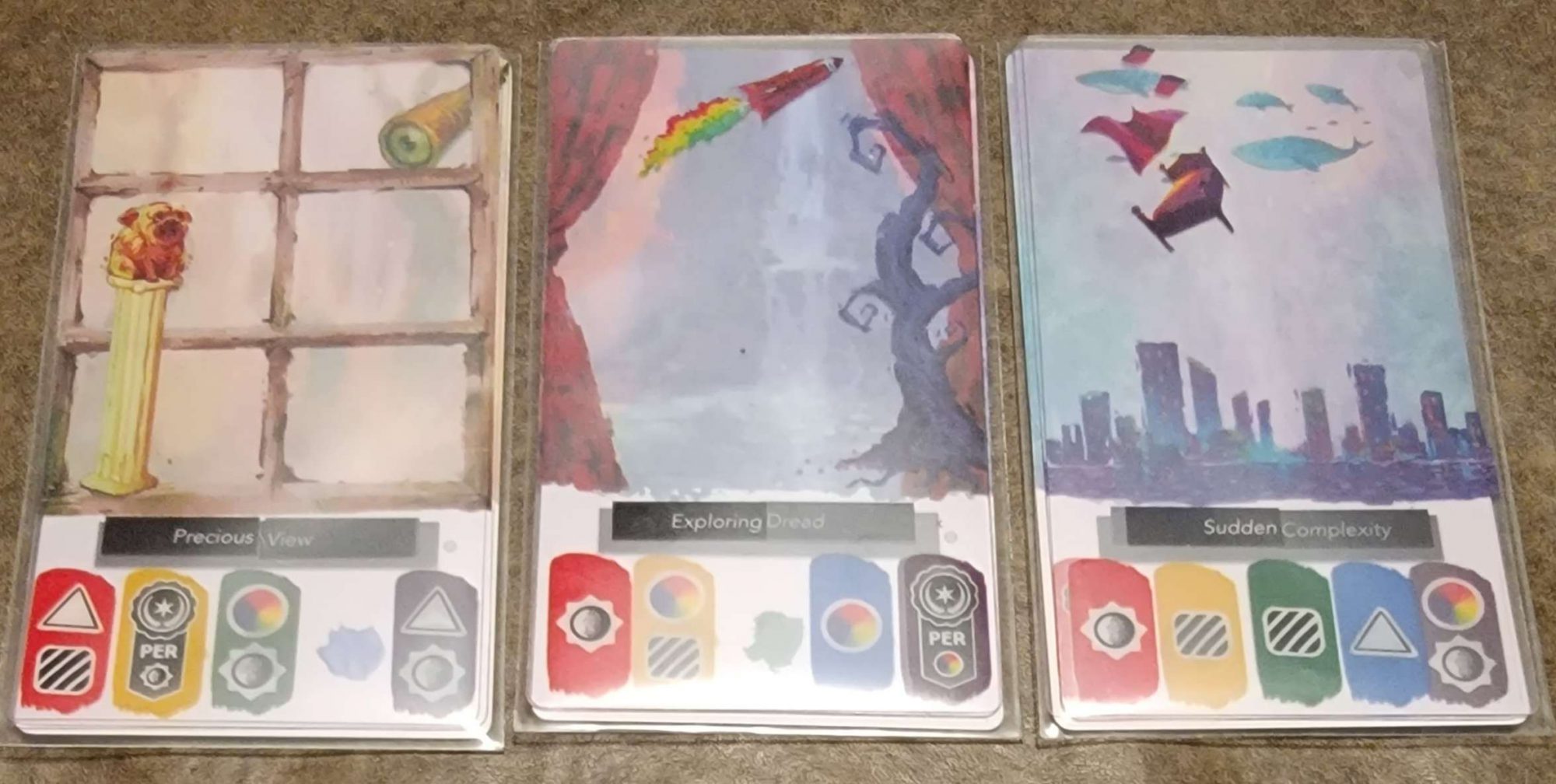
Different types of players can all sit down to play CANVAS together and enjoy it. This game is simple enough to teach to those who aren’t competitive scoring types, or those who aren’t great at strategy and just want a visually appealing piece to show. Canvas has the depth to accommodate all these folks, but is still enjoyable for players who just want to outscore the rest of the table. You just need to plan your Criteria Deck carefully rather than randomly deal them to the board.
Canvas includes one player variants and suggestions to make a more complicated multiplayer game, as well. The Kickstarter included little wooden easels to present your pieces on, which I absolutely loved until they arrived and constantly fell over from the slight weight of the art pieces. Until I find a way to make that moveable back a little more stable, I bought a pack of slightly bigger easels at the craft store which hold up better and still fit in the box, thankfully.
CANVAS is short but sweet with a run time of less than an hour and plays up to 5 people per game. I have the Kickstarter Deluxe version so my photos have wooden pieces that aren’t available in the basic standard version. The cardboard tokens for the standard version seem to be decent weight and are double sided, which is a bit more visually appealing on the table. CANVAS is a card based puzzle game that is simple to teach and easy to learn, with excellent replayability and is soon to deliver its second expansion. Look out for reviews on CANVAS: Reflections and CANVAS: Finishing Touches soon.
